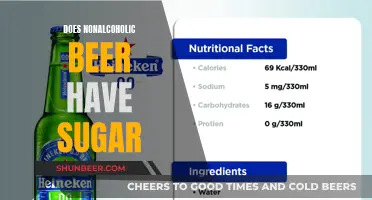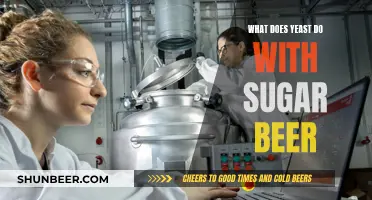
Beer is an alcoholic drink made by brewing and fermenting starches from cereal grains, most commonly malted barley. However, other grains such as wheat, maize, rice, and oats are also used. The starch in the grains is converted into sugars, which are then fermented to produce ethanol and carbonation in the beer.
Starch is a large-molecule carbohydrate, made up of carbon, oxygen, and hydrogen. It is stored in the form of granules inside special storage cells in the vegetative or reproductive organs of plants. Starch is the primary material from which fermentable sugars used in brewing are derived. During the malting, roasting, and mashing of barley, enzymes are produced that break down the starch into sugars.
The sugars produced in the mash are based on glucose and glucose polymers. If the glucose polymers grow big enough, they are known as starch. Starch can contain over 10,000 monosaccharide units.
The starch in beer grains is gelatinised before being enzymatically attacked and converted into sugars in the brewhouse. This process occurs at around 65°C for barley starch, but at higher temperatures for rice and corn, which must be cooked separately and added later.
| Characteristics | Values |
|---|---|
| What is starch? | A large-molecule carbohydrate used in making beer. |
| Starch composition | Carbon, oxygen, and hydrogen. |
| Starch types | Amylose (linear molecule) and amylopectin (branched molecule). |
| Starch source | Plants, including grains, tubers, and roots. |
| Starch function | Storing glucose until it is needed by the plant. |
| Starch in beer | Starch is the primary material from which fermentable sugars used in brewing are derived. |
| Starch conversion | Starch is converted into sugars to create wort, which is then fermented into beer. |
| Starch test | The iodine/starch test is performed to check for the conversion of starches into sugars. |
What You'll Learn
- Starch is a large-molecule carbohydrate used in making beer
- Starch is packaged as starch grains inside special storage cells until it's needed
- Starch grains must be gelatinised before they can be converted into sugars in the brewhouse
- Starch is the primary material from which fermentable sugars used in brewing are derived
- Starch is converted into sugars during the malting, roasting and mashing of barley

Starch is a large-molecule carbohydrate used in making beer
Plants make glucose, a sugar, during photosynthesis but need to store it until it is needed. Because glucose is a highly soluble and fairly small molecule, it attracts a lot of water into the plant cells. By joining several glucose molecules into fewer larger molecules, the amount of water drawn into the cell is much reduced, which makes storing it much less demanding. The larger molecule in question is called starch. Grain starch will be broken down into sugars to create wort, which will then be fermented into beer.
The plants store these starch granules in their vegetative organs (roots, stems, trunk) or reproductive organs (seeds, tubers, dried fruit). As a result, this starch is present in certain parts of plants all year round or at certain phases in their reproductive or growth cycles.
To brew beer, humans have explored and exploited all possible sources of starch offered by the plant world, without exception. The list of plants that over the millennia have provided starch for brewing beer is a long one. It includes grains such as barley, wheat, maize, rice, millet, rye, and oats; tubers with the highest yield such as cassava; leguminous plants such as beans, peas, and broad beans; and various sources of starch that play an important role in the brewing of traditional beers in the countries where they are grown, such as chestnut, carob, and carob-like.
Starch is not something you want in your finished beer. Yeast, at least the ones that produce good-tasting beer, do not eat starch. Only unwanted microorganisms in the brew can metabolize it, leading to problems such as overcarbonation, gushing bottles, sour beer, and bad-tasting beer.
Beer vs. Chardonnay: Which Has More Sugar?
You may want to see also

Starch is packaged as starch grains inside special storage cells until it's needed
Starch is a large-molecule carbohydrate used in making beer. It is a soft, white, tasteless powder that is insoluble in cold water, alcohol, or other solvents. Starch is a polysaccharide made up of glucose monomers joined in α 1,4 linkages. It is composed of the two glucose polymers amylopectin and amylose, which together form insoluble, semi-crystalline starch granules. The starch is packaged as starch grains inside special storage cells until it is needed.
The starch grains must be gelatinized before the starch can be enzymatically attacked and converted into sugars in the brewhouse. Gelatinization occurs at around 65°C for barley starch, which dictates the typical conversion temperatures used by brewers. However, gelatinization occurs at higher temperatures for rice and corn, demanding that they be cooked separately and added later to the main barley malt mash.
Beer's Sugar Impact: What Happens in the Body?
You may want to see also

Starch grains must be gelatinised before they can be converted into sugars in the brewhouse
Starch gelatinisation is an irreversible process that occurs when starch is heated in the presence of water. The starch granules swell and break, releasing amylose and amylopectin, and forming a thick solution due to the numerous hydrogen bonds with water. This process occurs at around 65°C for barley starch, which is why brewers typically use this temperature for conversion. However, gelatinisation occurs at higher temperatures for rice and corn starch, which is why they must be cooked separately and added later to the main barley malt mash.
The gelatinisation of starch grains is an important step in the brewing process as it is what allows the starch to be converted into sugars, which can then be fermented by yeast to create beer.
Dark Beer's Sweet Secret: Sugar Content Surprise
You may want to see also

Starch is the primary material from which fermentable sugars used in brewing are derived
Starch is a large-molecule carbohydrate used in making beer. To make any alcoholic beverage, there must be sugar present for yeast to ferment. Plants make glucose, a sugar, during photosynthesis but need to store it until it is needed. Because glucose is a highly soluble and fairly small molecule, it attracts a lot of water into the plant cells. By joining several glucose molecules into fewer larger molecules, the amount of water drawn into the cell is much reduced, which makes storing it much less demanding. The larger molecule in question is called starch. Grain starch will be broken down into sugars to create wort, which will then be fermented into beer.
Starch is a carbohydrate, meaning that it is built up from carbon, oxygen, and hydrogen, literally, carbon and water. Because starch contains many molecules of sugar, it is called a polysaccharide. Starch exists in two slightly differing forms, one a linear molecule and the other branched. The straight-chain form is called amylose and is usually about 10% to 30% of the starch present. The branched chain, called amylopectin, makes up 70% to 90%. Corn starch, for example, is 25% amylose and 75% amylopectin.
The starch is packaged as starch grains inside special storage cells until such time as it is required. The starch grains must be gelatinized before the starch can be enzymatically attacked and converted into sugars in the brewhouse. Gelatinization occurs at around 65 degrees celsius for barley starch, which dictates the typical conversion temperatures used by brewers. However, gelatinization occurs at higher temperatures for rice and corn, demanding that they be cooked separately and added later to the main barley malt mash.
The starch is the primary material from which fermentable sugars used in brewing are derived. Yeast is unable to use large and complicated starch molecules, so the starch must first be hydrolyzed into smaller carbohydrates. During the malting, roasting, and then mashing of barley, many of the enzymes normally present in the grain are destroyed. However, two enzymes persist, at least well into the mash. These are alpha- and beta-amylase, which, between them, are capable of hydrolyzing much of the starch present into sugars no larger than three glucose units long. Hydrolysis means literally "to add water", resulting in the starch being broken up and turned back into sugars.
Alpha-amylase attacks the bonds between glucose subunits in starch at any point in the chain, producing random-length carbohydrates. If left long enough, alpha-amylase will reduce amylose into a soup of glucose, maltose (a disaccharide with two glucose rings), and maltotriose (a trisaccharide with three glucose rings). Beta-amylase, on the other hand, starts at one end of the starch molecule and chops it up into pairs of glucose molecules, called maltose. Beta-amylase can only start its work from one end of the starch molecule, which slows things down.
The two enzymes work in concert in the mash tun, the alpha-amylase producing more ends for the beta-amylase and, between them, producing approximately 80% fermentable sugars in the form of 10% to 15% glucose, 50% to 60% maltose, and 10% to 15% maltotriose from the original starch. The remaining 20% consists of the non-fermentable fragments of amylopectin containing the branch points because neither enzyme is capable of breaking them down. These fragments of the amylopectin molecules are called limit dextrins. Endogenous industrial enzymes such as glucoamylase are able to hydrolyze even branch points and so can produce 100% fermentable sugars from amylopectin.
How to Properly Use Sugar for Beer Carbonation
You may want to see also

Starch is converted into sugars during the malting, roasting and mashing of barley
Starch is converted into sugars during the malting, roasting, and mashing of barley in the brewing process. This process is essential to making beer, as yeast needs sugar to ferment and produce alcohol.
Malting
Malting is the process of converting barley or other cereal grains into malt for use in brewing. It involves germinating the grains by soaking them in water and then drying them with hot air to stop further germination. During malting, enzymes are developed or activated in the grain, which break down the starches into various types of sugar, including glucose, maltose, maltotriose, and maltodextrines. The point at which the malting process is stopped affects the starch-to-enzyme ratio, and the amount of starch that gets converted into fermentable sugars.
Roasting
Roasting is the process of heating the malted grains in an oven or kiln to the desired color and specification. The temperature used for roasting depends on the type of malt being produced, with temperatures up to 140 °C used for roasted malts to achieve a darker color and roasted flavors.
Mashing
Mashing is the process of mixing ground malt with hot water to convert the starch in the malt into fermentable sugars. The key change during mashing is the degradation of starch into sugars, mainly maltose and glucose, which will be used by yeast for fermentation. The mashing process involves the activity of enzymes such as alpha-amylase and beta-amylase, which break down the starch molecules into smaller carbohydrates. The temperature and duration of mashing, as well as other factors like pH and grist size, can impact the efficiency of starch conversion and the profile of fermentable sugars produced.
Beer and Sugar: What's the Connection?
You may want to see also
Frequently asked questions
Beer is an alcoholic beverage produced by the brewing and fermentation of starches from cereal grains. The starches are converted into sugars, which are then fermented into ethanol and carbonation in the beer.
Starches are large-molecule carbohydrates used in making beer. Starch is a polysaccharide, meaning it is built up from carbon, oxygen, and hydrogen. Starch exists in two forms: a linear molecule called amylose and a branched molecule called amylopectin.
Sugars are carbohydrates that are smaller than starches. There are three monosaccharides: glucose, fructose, and galactose. When two glucose molecules are joined together, they form maltose. Glucose joined with fructose makes sucrose, and glucose joined with galactose forms lactose.
Yeast is a microorganism that ferments the sugars extracted from grains, producing alcohol and carbon dioxide, and thereby turning wort into beer.
The most common source of starch used in beer is malted grain, typically barley. Other sources include wheat, maize, rice, oats, rye, millet, sorghum, and cassava, among others.







